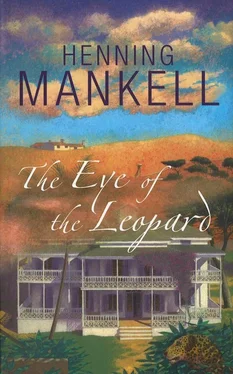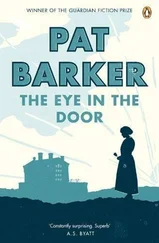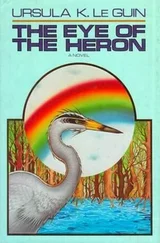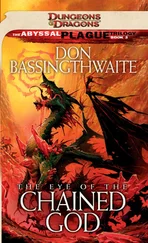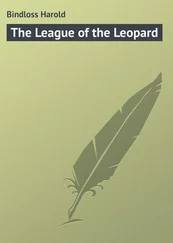Janine with her trombone...
Janine with her noseless face and her incredible gesture of inviting them into her house instead of calling the police, transforms that year, 1957, into a fairy tale they doubt they will ever experience again.
For Sture the move from the cathedral and residence in a city in Småland to this market town had seemed a nightmare. In a desolate and snowed-in Norrland he would go under, he was convinced of that. But he found a warrior and together they found Janine...
Hans creates a huge dream for himself which he can crawl inside like a voluminous overcoat. He realises at once that he loves her; in his dreams he furnishes her with a nose and transforms her into his vicarious mother.
Even though Janine is their common property, separate walls close tightly around their experiences. One cannot share everything; secrets must be carefully kept to oneself. A piece of crucial wisdom on life’s arduous path is to learn which dreams can be shared and which must be kept inside one’s own secret rooms.
Janine watches, listens and senses. She sees Sture’s tendency towards arrogance and bullying, she senses Hans’s longing for his absent mother. She sees the chasms that exist there, the huge differences. But one evening she teaches them to dance.
Kringström’s orchestra, which had played at every Saturday night dance since 1943, has testily accepted the challenge emanating from the increasingly discontented youth and has reluctantly begun to alter its repertoire. One Saturday in early spring they surprise everyone, not least themselves, by striking up a tune that might be related to the new music pouring in from the USA.
On this very evening Sture and Hans are hanging around outside the People’s Hall. Impatiently they are waiting until they’re big enough to buy their own tickets and step on to the crowded dance floor. The music comes through the walls, and Sture decides it’s time they learned how to dance.
Later that evening, when they are frozen and stiff, they wander down by the river bridge, race each other and yell underneath the iron span, and they don’t stop until they are standing outside Janine’s door. Music is coming through the walls. She’s playing tonight...
When she realises that they want to learn to dance, she is ready at once to teach them. Before the surgeon deformed her face, she had danced quite often. But she has not moved across a dance floor since. With a firm grip around the waist and simple repeated steps to the left and right, she leads them into the rhythmic stamping of the waltz and foxtrot. She keeps pressing them to her, one after the other, and sweeps around on the linoleum of the kitchen floor. Whoever is not dancing runs the gramophone, and soon the windows are fogged up from their efforts to follow and keep track of the steps.
From a kitchen cabinet she pulls out a bottle of homemade booze. When they ask where she got hold of it she just laughs. She offers each of them only a little glass, but keeps on drinking until she gets drunk. She lights a cigar and blows smoke out her nose hole, while claiming to be the world’s only female locomotive. She tells them that sometimes she imagines how she will leave Hurrapelle’s penitent bench and vanish into the world of carnival sideshows. She will never be a prima donna on the slack wire, but perhaps a freak who can elicit horror from the crowd. Exhibiting deformed people for money is a tradition that has been lost in the mists of time. She tells them about the Laughing Kid, who had the corners of his mouth sliced open to his ears and was then sold to a carnival troupe and made his owners rich.
From a kitchen drawer she takes out a red clown nose which she fastens with an elastic string around her head, and dumbstruck they watch this woman who radiates so many contradictory powers. What is hardest to understand but also most disturbing is how Janine can live this double life: the barefoot dance on the kitchen floor, the booze in the cupboard; the hard pews in Hurrapelle’s church.
But her salvation is no fabrication. She has her God securely placed in her heart. Without the fellowship that the congregation once extended to her she would no longer be alive. This is not to say that she is attracted to or professes all the beliefs of the congregation. Raising money to send missionaries to distant Bantu tribes in Africa she considers not only meaningless but a serious violation of the decree that all faith must be voluntary. When the women of the congregation meet in sewing circles for the production of table runners to sell at fairs, she stays home and sews her own clothes. She is a restless element in the congregation’s world, but as long as she can single-handedly collect the majority of its annual income by knocking on doors, she does not hesitate to indulge her freedoms. Hurrapelle makes regular attempts to coax her into the sewing circle, but she refuses. Since he’s afraid she might begin to waver in her faith, or even worse, move her God to a competing congregation, he doesn’t press the issue. When the members of the congregation complain about her self-indulgent behaviour, he deals sternly with the criticism.
‘The least of my children,’ he says. ‘Think of her suffering. Think how much good she is doing for our congregation...’
The evenings with Janine during that year become an unbroken series of peculiar encounters. Against a background of ‘Some of These Days’ she holds her hand over the two vandals who in the malevolence of ignorance once decided to torment the life out of her.
Both of them, each in his own way, find in her something of the mystery they had previously sought in vain in the town. The house by the south bank of the river becomes a journey out into the world...
On the evening she starts teaching them to dance, they experience for the first time the exciting sensation of being close to a warm, sweaty female body.
And the thought occurs to her — maybe not just at that moment, but later — that she would like to take off her clothes and stand stark naked before them, to be seen just once, even if it’s only by two skinny, half-grown boys.
At night come the dark powers that are never permitted to surface and burn. To cry out her distress and follow Hurrapelle’s admonition always to surrender to God, who keeps His ear in constant readiness; that would be impossible. There the religious thread breaks, and then she has no one but herself to cling to. The greatest of all the sorrows she has to bear is that she has never had the chance to sink into an embrace, even in the dirty back seat of a car parked on a remote logging road.
But she refuses to complain. She has her trombone. In the dawn of winter mornings she stands in her kitchen and plays ‘Creole Love Call’.
And the boys who brought the sack of ants — she always lets them in. When she teaches them to dance she feels happy that she could overcome their childish shyness...
During the late winter and early spring of 1957, Sture and Hans spend many evenings at her house. They often don’t go home until the winter night has driven its frozen ship towards midnight.
Spring arrives again. One day the unassuming but eagerly awaited yellow crowns of the coltsfoot begin to glow in a dirty ditch. Hurrapelle stands one morning in the back room of the Baptist church and searches in a cardboard box for handbills announcing the Spring Meeting. Soon it will be time for even the sermon placards to change their skin.
But spring is deceptive, because its beauty barely conceals the fact that death is hiding in the eye of the coltsfoot blossom.
For Sture and Hans, death is an invisible insect that eats away at life and every event. Long evenings they sit on the boulder by the river or in Janine’s kitchen and ponder how death actually ought to be understood and described. Sture suggests that death ought to be like Jönsson, the restaurant owner, who stands on the doorstep of the Grand Hotel and welcomes his guests in a black, greasy tuxedo. How easily he could then drip poison into the black soup or the sauce on the roast beef. He would lurk by the swinging doors to the kitchen and the tablecloths would be transformed into stained shrouds...
Читать дальше
